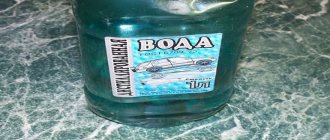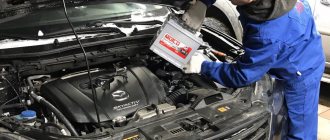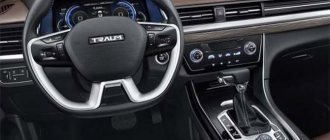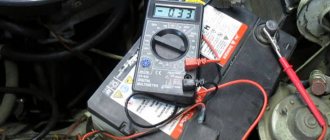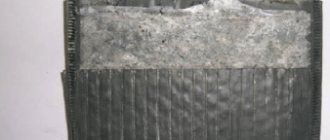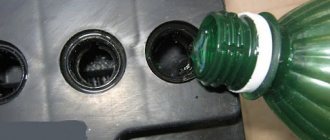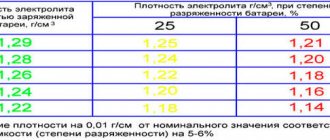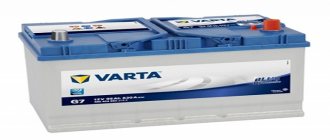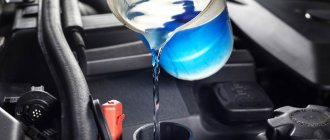About the Wheelbarrow ⁄ Maintenance and repair ⁄
When using batteries, the electrolyte level in the banks inevitably decreases. It’s easier with maintenance-free batteries - the fluid level in the compartments remains virtually unchanged for 5-6 years. As for serviced batteries, owners constantly have to monitor the electrolyte level and take timely measures. In this article we will tell you how to add distilled water to the battery, how much it is needed and whether it can be replaced with something.
Where to get distilled water for batteries
About 20 years ago, motorists had no questions about purchasing distilled water - it was sold in almost every pharmacy. Now the situation has changed. The fact is that this liquid is suitable for use for medical purposes for three days, so you can only get it at a pharmacy that has its own distiller.
Modern alternatives:
- auto parts stores;
- gas stations with a retail outlet;
- hardware stores (distilled water is used in irons and steamers).
Another option is to search for water in online stores. It is suitable for those who want to stock up for future use. The delivery time, depending on the region, can be several weeks; this method is not suitable for emergency topping up of fluid in the battery.
Some motorists do not want to waste time visiting stores and wonder whether it is possible to fill the battery with plain or boiled water. The first option is absolutely not suitable. Tap water contains foreign substances - chlorine, magnesium, phosphorus, etc. When charging the battery, they will settle on the lead plates. At best, this will lead to a decrease in battery capacity, at worst, to a short circuit and failure of the battery.
As for boiled water, it cannot fully replace distilled water; it contains metal salts, albeit in small quantities. This option is suitable if you urgently need to put the battery “on alert”, but then you will have to rinse each jar and fill in new electrolyte.
An attempt to replace distilled water with boiled or some other water can lead to a decrease in battery capacity, destruction of lead plates and other unpleasant consequences.
When is battery refilling required?
Most experts believe that car batteries do not require maintenance. Accordingly, adding water to it is irrelevant, but provided that the battery is used under normal conditions. It is imperative to check the fluid level for motorists who travel long distances in their own cars. In this case, the probability of converting the liquid into a vapor state is greatest. And also the active process of water evaporation is carried out in the event of failure of the relay regulator.
Main indicators of failure of the relay regulator:
- during the operation of the vehicle, the battery becomes very hot;
- drops of electrolyte are observed on the battery body;
- Strong steam comes out of the filler necks.
It is necessary to take into account the design of the battery. In serviced models, much greater evaporation of H2O occurs. Therefore, it is for them that it is worth knowing how much water to add to the battery. In maintenance-free models, evaporation of liquid into the environment is prevented by a sealed cast housing. Such batteries do not require additional maintenance.
How to add distilled water to a car battery correctly
If the density of the electrolyte in your battery has increased or you notice that it does not produce the required voltage, most likely the reason is a decrease in the amount of distilled water. Normally it should be 65% to 35% sulfuric acid.
Sequence of work when adding distillate to the battery.
To correctly add liquid to the jars, use the instructions.
- Remove dirt and dust from the top of the battery, especially around the plugs.
- Wipe the area around the necks with a rag soaked in soda solution to neutralize any sulfuric acid that may have splashed out during charging.
- Carefully unscrew the plugs - protect your hands from exposure to electrolyte.
- Take a medical syringe, syringe or hydrometer and fill with distilled water.
- Pour liquid into jars with insufficient electrolyte levels.
- Tighten the plugs.
- After 2-3 hours, check the density of the electrolyte with a hydrometer (normal value in the table below).
- If everything is done correctly, put the battery on charge.
Adding distilled water to the battery should be done on a horizontal surface. Otherwise, the level of liquid in the jars will be different, so you will either overfill or underfill.
The recommended battery electrolyte density depends on the climatic conditions of your region.
| Climate zone | Electrolyte density (g/cm3) |
| South of Russia | 1,25 |
| Middle lane | 1,27 |
| North and Siberia | 1,29 |
To ensure accurate results when measuring the density of the electrolyte, hold the hydrometer vertically and do not allow the float to touch its walls. Having collected the electrolyte into the flask, gradually reduce the pressure so that the float floats freely. If you were able to achieve this, pay attention to the place where the liquid comes into contact with the scale. This will be the density of the electrolyte in the battery.
Check the density of the electrolyte after adding distilled water to the battery.
Why is no electrolyte used?
During the operation of the battery, especially in the summer, the battery heats up, as a result of which the jars may boil. The DW evaporates at this moment. Acid is a non-volatile liquid; accordingly, it remains and the concentration of water decreases. The density of the mixture sometimes increases to 1.4 g/cm 3 . Therefore, in order to bring the electrolyte to normal density, it is necessary to add DV.
If you pour electrolyte, the density will decrease, but not enough.
It is important to remember about salt precipitation and destruction of the plates. Therefore, in order to reduce the density of the liquid to the established norm, only DV is added. This rule must always be remembered!
It is also worth remembering that water is added only to batteries of the type being serviced, which are characterized by maximum evaporation. Maintenance-free batteries are equipped with a molded sealed case; the evaporated liquid does not come out, it precipitates inside the can. In this case, a closed cycle occurs; there is no need to add water.
How much distilled water should I add to the battery?
In a modern battery, the easiest way is to understand how much distilled water needs to be filled. Its body is made of transparent plastic with a scale printed on it. It is enough to ensure that the level recommended by the manufacturer is not exceeded.
If you have a different type of battery, use the following tips.
- In some batteries, metal or plastic is located just below the neck of the can. The electrolyte level should be 5 mm above the “tongue”.
- If there are no marks in the jar, add distilled water so that the electrolyte level is 10-15 mm higher than the lead plates.
- If you cannot visually determine how much electrolyte is in the jar, take a glass tube, lower it into the compartment, pinch the top with your finger and carefully remove it. The amount of liquid in it will be equal to the distance from the lead plates to the surface of the electrolyte.
Try to follow the pouring rules to achieve the correct ratio of hydrochloric acid to distilled water.
If there is more acid, it will destroy the lead parts of the battery; if there is less acid, the battery will defrost at subzero temperatures.
Checking the electrolyte level
The presence of electrolyte is checked exclusively in serviced batteries. They are most often equipped with a transparent body, so inspection is carried out visually. For this purpose, special marks are made on the surface corresponding to a certain volume of liquid.
Serviceable batteries with an opaque casing are also available. To determine to what level to add water to the battery in this case, the vehicle owner will need a special transparent tube with a diameter of 0.5 cm.
Fluid level check sequence:
- The battery cover is unscrewed;
- the transparent tube is lowered into the liquid, and it should rest against the bottom of the jar;
- its outer hole is clamped tightly with a finger;
- it is then removed from the battery to determine the electrolyte level.
Such a tube has minimum and maximum divisions. Accordingly, if the accumulated liquid is within these limits, the volume of electrolyte is normal. If the fluid is below the minimum, you need to add DV.
How to make distilled water at home
Some car enthusiasts prefer not to buy distilled water, but to make it themselves. Usually these are people of the older generation, accustomed to times of scarcity and who do not want to change. But residents of remote villages where there are no shops have to adapt in a similar way.
Let us immediately note that it is impossible to obtain high-quality distilled water at home. To do this, you need a distiller, the cost of which is not comparable to the price of a bottle of water. As an alternative, you can use a moonshine still if you remove the coil from it. But the yield of distilled water with this method is insignificant - about a glass in 3-4 hours.
Distilled water has the formula H2O, that is, it does not contain foreign impurities. No matter how hard you try, it is almost impossible to get a similar result at home - a small part of the metal salts will remain in the water.
If you urgently need to top up the battery with water, put it in a plastic bottle and put it in the refrigerator for 2-3 hours. Then drain the unfrozen water into the sink, and melt the ice and use it to pour into jars. In this case, the damage to the battery will be minimal.
You can collect rainwater in a plastic container, then carefully filter it and use it for its intended purpose.
It is important that the water does not come into contact with metals. For example, the one that drips from tin roofs is not suitable for filling the battery.
Obtaining distillate at home
There are motorists who do not go to the store for DV. They produce it themselves at home. This is mainly the older generation, who lived through times of shortage, and people living in settlements remote from the city, where many products simply do not arrive.
If you want to prepare DV yourself, you should understand that it will not be of high quality, since for this you need to have special expensive equipment - a distiller. But as an alternative, a regular moonshine still without a coil is suitable. The productivity of the DV when using this option will be approximately 1 glass in 3-4 hours.
The formula of distilled water is H2O. A high-quality liquid should not contain foreign impurities. It is impossible to achieve such a result under domestic conditions; a small content of metal salts will still remain.
Recommendations:
- If you urgently need to add water to the battery, you can take it from the tap into a plastic bottle and put it in the freezer for 2-3 hours. You should only use ice that has been melted beforehand. Unfrozen water is drained into the sink. The DV obtained in this way will cause minimal damage to the battery.
- Another way is to collect rainwater in a plastic container, carefully filter it, and then use it for its intended purpose.
Important! The collected water for the battery should not come into contact with iron objects. For example, water running off the metal roof of a house is not suitable for this purpose.
When using batteries, the electrolyte level in the banks inevitably decreases. It’s easier with maintenance-free batteries - the fluid level in the compartments remains virtually unchanged for 5-6 years. As for serviced batteries, owners constantly have to monitor the electrolyte level and take timely measures. In this article we will tell you how to add distilled water to the battery, how much it is needed and whether it can be replaced with something.
How to charge after topping up
Such batteries are not at all capricious, but still require some maintenance. The most common cases of battery malfunction: discharge and decrease in electrolyte levels. To solve problems, add water and charge.
Even if the part does not require deep, long-term charging, it is necessary to do so. During the process, the terminals can be cleaned of oxidation to ensure a strong connection. It is important to dry all surfaces of the case after filling the battery with water.
Attention! After topping up, the battery is charged after 3 or 4 hours.
3 charging methods worth using:
- Using direct current. Complex, but often used method. It is 100% infected, but it will take about 10 hours.
- Using constant voltage. There is less effect, but the method is simpler; it charges only 80% in a whole day.
- Combined. It is carried out using “smart” expensive equipment without much effort on the part of the device owner. Due to it, the charge level is checked automatically and the necessary voltage is supplied to replenish it. Boil-off and excessive current supply are completely eliminated. Such a charge will take approximately 12 hours, everything will depend on the degree of charge loss.
The most successful method is DC charging. Although the process requires constant monitoring, it gives good results.
Note! If you add water but do not charge the part, the engine will operate at an elevated temperature, which means the liquid will boil away faster. Consequently, the discharge will occur faster.
Battery distillate is a very important component, so it makes a difference what kind of water you fill. It is necessary to create the optimal concentration of electrolyte solutions, replenish the correct ratio and prevent overheating in the device. The main condition remains the use of a high-quality mixture that meets all norms and standards. The pouring process should not be performed frequently. In winter, you should not add water at all, since the electrolyte mass will be diluted, which means it may freeze.
What happens if you fill in the wrong liquid?
If you use ordinary untreated water, deposits can quickly form on the electrodes. Because of them, the plates may collapse.
Poor quality water leads to deterioration of electrical conductivity. The resulting sediment subsequently leads to rapid battery discharge. The result may be its complete failure.
If you add an inappropriate component, it is possible:
- accelerating the process of battery loss of water included in the electrolyte;
- increasing the resistance of battery plates;
- increasing the density of the electrolyte itself.
Even a single use of undistilled water can lead to sedimentation. As a result, the system will be short circuited.
A guide to restoring equipment using distillate
Over time, the amount of lead sulfate deposited on the plates becomes so large that the battery completely loses its original properties.
The only way to revive it from this state is to carry out desulfation, that is, to remove these salts.
There are several ways:
- Mechanical.
- Chemical.
- Electrochemical.
The first option involves disassembling the case, removing the plates, and then mechanically manually cleaning them from salts.
The second uses a lead sulfate corrosive agent. However, the effectiveness of both methods is quite questionable, since as a result the battery may become unusable.
The third method is the most optimal. It uses a special charger with a desulfation function.
Its application is quite simple:
- Connect the battery filled with distilled water to the charger.
- Plug in and monitor the display indicators.
If such a device is not available, you can use a standard charger according to the following instructions:
Bring the battery level to the mark with distilled water.- Connect to the charger and set the current to 14 V and 1 A.
- Leave to work for 8-10 hours.
- Disable for 24 hours.
- Next, connect the charger to 14 volts and 2 amperes.
- Leave it to charge for 8 hours.
As a result, the battery voltage should increase to 12 V, and the electrolyte density to 1.12. Then, a day later, a low-beam light bulb is connected to the battery. It should work until it discharges to 9 volts with the same density.
After this, all previous steps are repeated. In this case, the density indicator should increase to 1.16. The procedure should be repeated sequentially until its value increases to 1.28.
Why add?
Periodically, clean water must be added to the device. This is done for the following purposes:
- replenishment of previously boiled away water mass;
- preventing overheating of the battery mechanism;
- reducing the concentration of sulfuric acid in the mixture;
- improving the process of accumulating a mixture of electrical charges necessary for battery operation.
Reference. The distillate is added to the battery to preserve the battery plates. Sulfuric acid melts them because they are made of lead. The purified aqueous composition slows down the process of destruction and mitigates the negative impact of the aggressive internal environment on them.
